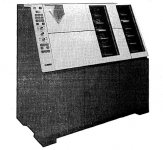morpheus256
Member
Well I've gone and done it, I spent 4hrs in the car to go pickup a Baby S/36 system, with host PC, monitor, keyboard, 8 Binders of manuals, 2 boxes of disks, and spares.
So far I've powered on the 5170 to be greeted with a 161 error, Going to need to find a battery and reconfigure that before going any futher.
The 5170 is loaded with:
The 5364 is loaded with:
I also got some spare cards for the 5364, Looks like a processor card, Memory card, and RTC card?
I'll take some pictures later if there's interest.
So far I've powered on the 5170 to be greeted with a 161 error, Going to need to find a battery and reconfigure that before going any futher.
The 5170 is loaded with:
- 1x5.25, 1x3.5 Floppy
- 1xST238R HDD
- 2x Serial cards
- 1x MDA/Parallel
- 1x Memory card
- 1x S/36 "Driver Board"
- FDD/RLL controller
The 5364 is loaded with:
- 1x5.25 Floppy
- 2x40MB ESDI?
I also got some spare cards for the 5364, Looks like a processor card, Memory card, and RTC card?
I'll take some pictures later if there's interest.


